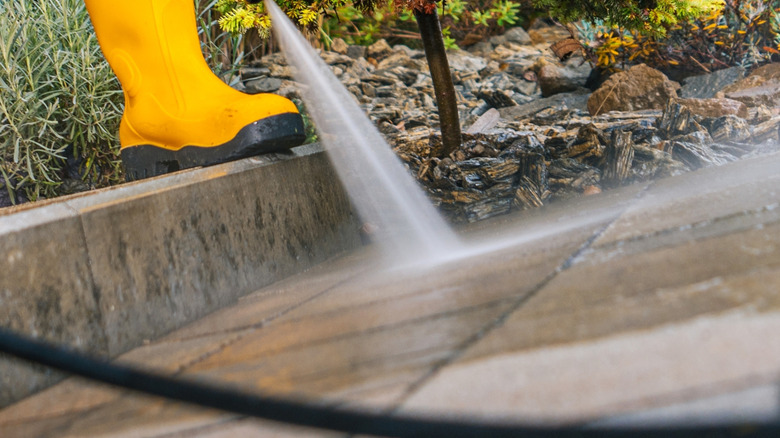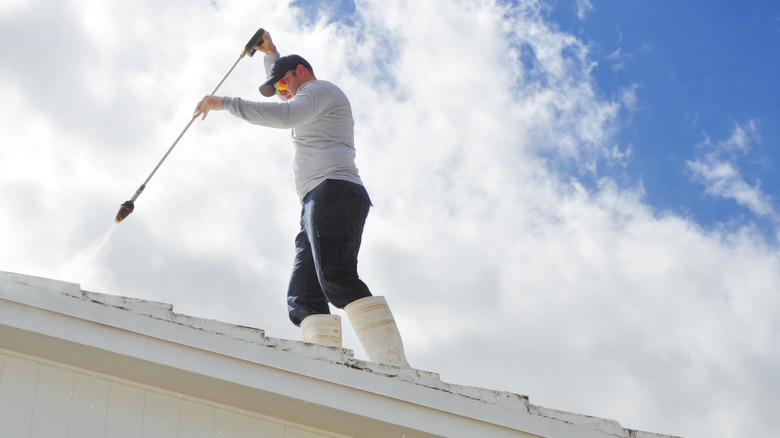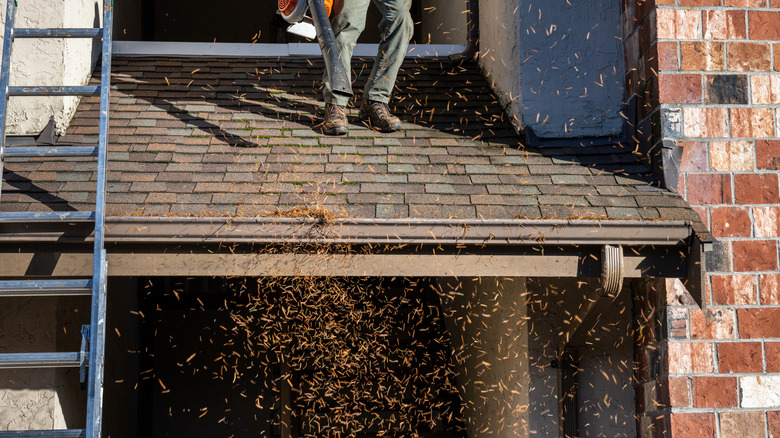The Exterior Feature You Should Never Try Cleaning With A Pressure Washer
There's almost nothing more rewarding than cleaning with a pressure washer. Whether you're blasting stains off of siding or getting grime off the driveway, the powerful spray can clean tons of things around your house to dazzling results. Outdoor spaces can go from dingy to sparkling in a matter of minutes (and as a bonus ... you can post the incredibly satisfying before and after photos to prove it!).
But as fun and effective as the tool is, there are a few things you should never clean with a pressure washer. One of these is your roof, particularly if it has asphalt shingles. For one, pressure washing a roof can be super dangerous. Additionally, the pressure of the water spray can damage critical parts of the shingles, including the protective coating and the adhesive that bonds them to the roof. That damage could reduce the life span of the shingles and eventually jeopardize the integrity of the entire roof assembly. In short, the risks just don't outweigh the benefits, especially since there are several safer alternatives to cleaning your roof.
The dangers of pressure washing a roof
The first hazard associated with pressure washing a roof is the risk of personal injury. The water jet can make it hard to control where the water goes, so you may end up standing on a slippery surface. This, in turn, can lead to slip-and-fall accidents with life-altering consequences.
Additionally, pressure washing can cause damage to your roof in a few ways. If you have asphalt shingles, they likely have a protective coating. This layer guards the shingles from outdoor elements like UV rays, high winds, and rain. And while the protective layer can hold up against heavy precipitation, the concentrated force of a pressure wash is far more powerful than rain. The pressure can easily strip the coating from the shingles and break down the adhesive bond that keeps them attached to the roof. With damaged coating and adhesive, the shingles become more susceptible to the elements. They'll deteriorate quicker and may wiggle out of place, possibly making way for water or other gunk to seep through the roof and into your home. Water ingress through the roof could lead to even more severe and expensive damage.
If you're still tempted to pressure wash the roof, there's one more thing to consider — your roof warranty or homeowner's insurance. Many insurance plans discourage or outright prohibit pressure washing the roof because of the risk of damage associated with this cleaning method. This means that if you harm the roof in the process, neither the warranty nor the homeowner's insurance would cover you, and you'd have to pay for the repairs.
Alternatives to pressure washing a roof
Luckily, there are several ways to effectively clean a roof without pressure washing. Use a soft-bristled broom or leaf blower to brush or blow loose, dry debris away. For stubborn issues, like mildew or moss, use water and a tile-safe cleaning solution. Avoid anything too abrasive for asphalt tiles — a mixture of equal parts vinegar and water can often do the trick, or you can try a stronger solution of 75% bleach and 25% water for tougher stains. Apply the cleaning solution with a gentle sponge and then use your hose on a low level to rinse the solution away.
No matter what method you choose, make sure to use appropriate safety gear like non-slip shoes, a fall arrest harness, and a sturdy ladder. Prepare everything you need before you start the job and keep it easily accessible on the roof so you're not having to continuously climb up and down. It's also wise to keep a spotter on hand.
Lastly, if your roof is in need of a major cleaning, consider hiring professionals. The upfront cost might be higher than if you did the job yourself. But considering the potential sky-high costs of injury or roof damage, this route might wind up saving you tons in the long run.


